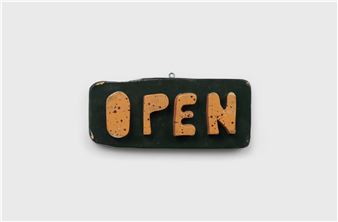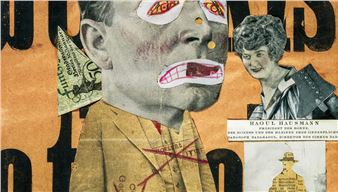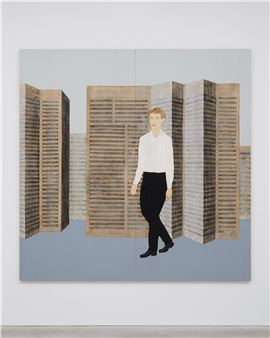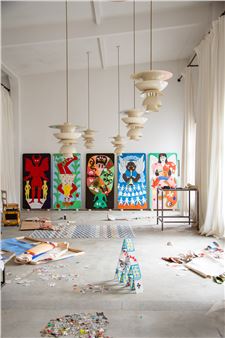Down to Earth
‚ÄúDown to Earth‚ÄĚ is both an exhibition and a programme involving experts, music, live art and an academy space that explores how the agenda of a shift in climate policy affects our own ‚Äúoperating system‚ÄĚ. How can we sustainably change the mode in which we work, eat, travel or make exhibitions?
Checkpoint: ‚ÄúDown to Earth‚ÄĚ is free time. Time in which to come to rest, to listen, watch, talk and move on: analogue time, time to waste, time to turn difficulties into valuable experiences.
The largest system that we are part of rather than looking at from the outside is the climate ‚Äď together with many other agents, we create what we have to etndure. Covid-19 forced us to take a giant break, it brought about a vast ceremony of deceleration. The skies above Northern Italy and Beijing turned blue again, the rivers became cleaner and the social issue was clear. Or was it? Conditions in slaughterhouses, in asparagus fields, what we do to people, animals and the landscape became visible during the crisis. So did solidarity and the voices of scientists and experts. Millions of people on every continent were locked down and have been working to solve the same problem ever since. No art work could achieve this.
Only 11 September and the revolution across Eastern Europe in 1989 have come close to involving us all, mobilising everyone in the way THE VIRUS has. And now? Hardly anyone wants to carry on as before. But where can we land? Like many people nowadays, we have read Bruno Latour‚Äôs climate texts. What is the ‚Äúthird attractor‚ÄĚ? Will it help us to disengage from the old battle of right against left, the left against the past, the right against the queer?
We want to play a different game. Immersion is new ground ‚Äď a monument to uncertainty. Unsecured territory. Unsafe. Uncategorised. We have yet to be categorised. Which is good. This isn‚Äôt theatre, it‚Äôs not an exhibition, not an exhibition with performances: it‚Äôs something different. The whole thing is a situation. We open in the morning and close late. It‚Äôs the summer. There will be things that you can see every day: objects, images, spatial installations ‚Äď and four weeks of talks, lectures, dance and music changing every day. Just imagine: you go to an exhibition and there will always be someone there for you.
When you walk through the rooms you will see images of our ocean planet by Kader Attia, Andreas Gursky and Jean Painlev√©. And in front of them a puddle from Neuk√∂lln by Kirsten Pieroth that never dries out. Stefanie Hessler has curated an exhibition within the exhibition with two rooms of photographs, installations and research projects devoted to the ocean that is then followed by Bruno Latour and Fr√©d√©rique A√Įt-Touati‚Äôs working space. Alicja Kwade‚Äôs work is shaped by the transition between natural and technological transformation and at the same time we also show both Agnes Denes‚Äô ‚ÄúTree Mountain‚ÄĚ project and her wheat field in the middle of New York. Joulia Strauss invites us to honour indigenous cultures and to discover marginalised forms of knowledge from other societies and ages. Together with a team of cultivators, Asad Raza mixes waste materials from the museum and the city into a room-filling 20 tons of ‚Äúneo-soil‚ÄĚ, which you can take home for your own projects. Next door Yngve Holen‚Äôs sawn up Porsche awaits, along with Vibha Galhotra‚Äôs soundless installation, dedicated to the death of bees around the world. We would like to thank Tom√°s Saraceno for the spider artwork which has already been living with us in the Gropius Bau for six months, while Tino Sehgal‚Äôs work ‚ÄúThis Situation‚ÄĚ is one for which we required no loan request and no insurance as it is immaterial and lives through you, among others.
All this is only half of it. There‚Äôs also a live programme. Every exhibition creates a public and we would like to use ‚ÄúDown to Earth‚ÄĚ to bring different publics together that rarely meet ‚Äď for example an activist academy from Athens and the college of academic associates of Bruno Latour and Fr√©d√©rique A√Įt-Touati, or the diverse communities of our experts on change, who are pioneers of solidary farming, salt water gardens on the roofs of tower blocks, repair caf√©s, and the tiny house movement. We will therefore put up one of these houses on the S√ľdplatz together with the audience, cook for them and eat together with them without using electricity. Music, experts, exhibits, live art, discussion ‚Äď these are the components of ‚ÄúDown to Earth‚ÄĚ: analogue music by Ensemble Extrakte, musical journalism by Andrea Voets and concerts from the Berliner Stegreif Orchester; our expert programme with over 30 pioneers of transformation and sustainability; performances and live art by and with Claire Vivianne Sobottke, Fran√ßois Chaignaud and Marie-Pierre Br√©bant, Jared Gradinger and Angela Schubot, Meg Stuart as well as Mansour Ciss Kanakassy.
‚ÄúDown to Earth‚ÄĚ will focus on the boundary between nature and culture and how it can become porous. An important element will be its audit of our own ‚Äúoperating system‚ÄĚ: 20 degrees Celsius, 50 % humidity in the exhibition hall ‚Äď how did that come about? How did our predecessors come to prescribe this standard of modernity for museums? How did they work in this building before air conditioning? How does our air conditioning work and where is it exactly? Which hotels are ecologically viable, which energy companies, how will our programme change if the people working with us have to come here by train?

Recommended for you
‚ÄúDown to Earth‚ÄĚ is both an exhibition and a programme involving experts, music, live art and an academy space that explores how the agenda of a shift in climate policy affects our own ‚Äúoperating system‚ÄĚ. How can we sustainably change the mode in which we work, eat, travel or make exhibitions?
Checkpoint: ‚ÄúDown to Earth‚ÄĚ is free time. Time in which to come to rest, to listen, watch, talk and move on: analogue time, time to waste, time to turn difficulties into valuable experiences.
The largest system that we are part of rather than looking at from the outside is the climate ‚Äď together with many other agents, we create what we have to etndure. Covid-19 forced us to take a giant break, it brought about a vast ceremony of deceleration. The skies above Northern Italy and Beijing turned blue again, the rivers became cleaner and the social issue was clear. Or was it? Conditions in slaughterhouses, in asparagus fields, what we do to people, animals and the landscape became visible during the crisis. So did solidarity and the voices of scientists and experts. Millions of people on every continent were locked down and have been working to solve the same problem ever since. No art work could achieve this.
Only 11 September and the revolution across Eastern Europe in 1989 have come close to involving us all, mobilising everyone in the way THE VIRUS has. And now? Hardly anyone wants to carry on as before. But where can we land? Like many people nowadays, we have read Bruno Latour‚Äôs climate texts. What is the ‚Äúthird attractor‚ÄĚ? Will it help us to disengage from the old battle of right against left, the left against the past, the right against the queer?
We want to play a different game. Immersion is new ground ‚Äď a monument to uncertainty. Unsecured territory. Unsafe. Uncategorised. We have yet to be categorised. Which is good. This isn‚Äôt theatre, it‚Äôs not an exhibition, not an exhibition with performances: it‚Äôs something different. The whole thing is a situation. We open in the morning and close late. It‚Äôs the summer. There will be things that you can see every day: objects, images, spatial installations ‚Äď and four weeks of talks, lectures, dance and music changing every day. Just imagine: you go to an exhibition and there will always be someone there for you.
When you walk through the rooms you will see images of our ocean planet by Kader Attia, Andreas Gursky and Jean Painlev√©. And in front of them a puddle from Neuk√∂lln by Kirsten Pieroth that never dries out. Stefanie Hessler has curated an exhibition within the exhibition with two rooms of photographs, installations and research projects devoted to the ocean that is then followed by Bruno Latour and Fr√©d√©rique A√Įt-Touati‚Äôs working space. Alicja Kwade‚Äôs work is shaped by the transition between natural and technological transformation and at the same time we also show both Agnes Denes‚Äô ‚ÄúTree Mountain‚ÄĚ project and her wheat field in the middle of New York. Joulia Strauss invites us to honour indigenous cultures and to discover marginalised forms of knowledge from other societies and ages. Together with a team of cultivators, Asad Raza mixes waste materials from the museum and the city into a room-filling 20 tons of ‚Äúneo-soil‚ÄĚ, which you can take home for your own projects. Next door Yngve Holen‚Äôs sawn up Porsche awaits, along with Vibha Galhotra‚Äôs soundless installation, dedicated to the death of bees around the world. We would like to thank Tom√°s Saraceno for the spider artwork which has already been living with us in the Gropius Bau for six months, while Tino Sehgal‚Äôs work ‚ÄúThis Situation‚ÄĚ is one for which we required no loan request and no insurance as it is immaterial and lives through you, among others.
All this is only half of it. There‚Äôs also a live programme. Every exhibition creates a public and we would like to use ‚ÄúDown to Earth‚ÄĚ to bring different publics together that rarely meet ‚Äď for example an activist academy from Athens and the college of academic associates of Bruno Latour and Fr√©d√©rique A√Įt-Touati, or the diverse communities of our experts on change, who are pioneers of solidary farming, salt water gardens on the roofs of tower blocks, repair caf√©s, and the tiny house movement. We will therefore put up one of these houses on the S√ľdplatz together with the audience, cook for them and eat together with them without using electricity. Music, experts, exhibits, live art, discussion ‚Äď these are the components of ‚ÄúDown to Earth‚ÄĚ: analogue music by Ensemble Extrakte, musical journalism by Andrea Voets and concerts from the Berliner Stegreif Orchester; our expert programme with over 30 pioneers of transformation and sustainability; performances and live art by and with Claire Vivianne Sobottke, Fran√ßois Chaignaud and Marie-Pierre Br√©bant, Jared Gradinger and Angela Schubot, Meg Stuart as well as Mansour Ciss Kanakassy.
‚ÄúDown to Earth‚ÄĚ will focus on the boundary between nature and culture and how it can become porous. An important element will be its audit of our own ‚Äúoperating system‚ÄĚ: 20 degrees Celsius, 50 % humidity in the exhibition hall ‚Äď how did that come about? How did our predecessors come to prescribe this standard of modernity for museums? How did they work in this building before air conditioning? How does our air conditioning work and where is it exactly? Which hotels are ecologically viable, which energy companies, how will our programme change if the people working with us have to come here by train?
Artists on show
- Agnes Denes
- Alicja Kwade
- Andreas Gursky
- Anne Duk Hee Jordan
- Armin Linke
- Asad Raza
- Brandon LaBelle
- Femke Herregraven
- Filipa César
- Helen Mayer Harrison
- Himali Singh Soin
- Jean Painlevé
- Joulia Strauss
- Kader Attia
- Kirsten Pieroth
- Louis Henderson
- Marina Naprushkina
- Michelle-Marie Letelier
- Miriam Simun
- Peter Handke
- Peter Weibel
- Simryn Gill
- Sissel Tolaas
- Susanne Winter
- Tino Sehgal
- Tomas Saraceno
- Vibha Galhotra
- Yngve Holen
Related articles
We can detect the names of logos more easily than leaves on the ground, and we kill organisms in order to keep others alive.
Asad Raza’s expansive cross-disciplinary practice defies categorization. Situated somewhere between performance, installation and curation, its elusiveness can be attributed to many factors.

 ARTISTS
ARTISTS















